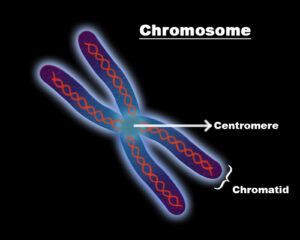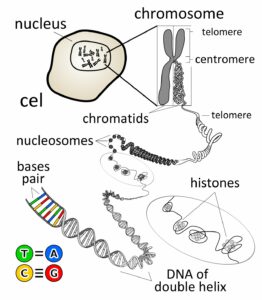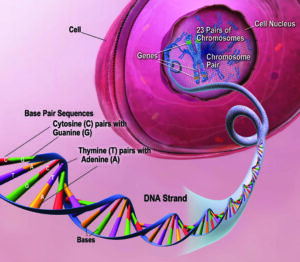Chromosome is a region or a portion in the nucleus of a cell which has the genetic material in it.
Why chromosomes are in pairs- The term diploid means 2n where ‘ n ‘ means number of chromosomes, one from each parent. Combination of the sex cells, which is haploid- the male gamate ( sperm ) with the female (gamate ovum) makes it diploid and this is why they come in pairs.
Human have 23 pair of chromosome in which 22 pair of chromosomes are autosomes and the other 1 pair is the sex chromosome which defines whether the offspring is boy or girl
In the case of Boy, it will be X Y chromosome
In the case of Girl, it will be X X chromosome.
Females in general give X chromosomes to their offspring but male can give X or Y.

Image credits- Flickr
If the male give the X chromosome so it will
X (from the male) and X (form the female) so it will be X X that is the offspring will be a girl.
If the male gives the Y chromosome, so it will be
X (from the female) and Y ( from the male) so it will be X Y that is the offspring will be a boy.
X Y – Male
X X – Female
Read More on Do Bacteria Have Chloroplasts? Why, What Type, How And Detailed Facts
How are chromosomes arranged in pairs?
Chromosomes are arranged in pairs as one is inherited from one parent and the other is inherited from the other biological parent.
Karyotype: The ultimate chromosome complex inside the nucleus is called the karyotype. This karyotype is a laboratory imaging technique that is used to identify any defective or abnormal portion in the chromosome.
Read More on Chromatin Organization | Its Crucial impact on the packaging of DNA
In research, it is used to identify the length of the chromosome and other factors.

Image credits- Wikimedia
Read more on Biosynthesis of Purines and Pyrimidines | An important part of cellular metabolism
Are chromosomes always in pairs, if Yes, Why chromosomes are in pairs?
Chromosome being just resembling a hair-like structure contains a lot of information for an organism to sustain on this earth.
It is not necessary that chromosomes that are present in each and every organism should be in pairs but yes, the majority of the chromosomes are in pairs.
We know about the diploid and haploid terms in genetics.
Haploid is when only 1n is present
Diploid is when 2n is present
Where n is the total number of chromosomes present inside.
We just saw that in pairs one chromosome is obtained from one biological parent and the other from another biological parent.
The pairing of this chromosome is based on the matching pairs that is the specific type of chromosome in the male organism pairs with the same specific type of the chromosome from the female organism.
So the final conclusion is that the pairing happens only for the diploid cell type and not for haploid cells.
Examples of diploid cells are the muscle cells, blood cells, skin cells.
Examples of haploid cells are sperm cells, ova cells, all bacteria like E. coli and other organisms that replicate with only one parent.
Read More on Is Fungi Prokaryotic Or Eukaryotic: Why, How And Detailed Insights And Facts
How are chromosomes held together?
In order to be in pairs, chromosomes should possess a meeting point or the region of attachment.
Centromere is the region in the paired chromosome in which the pair of chromosomes are held tightly together. It is a narrow or constrictive spot in which both the sister chromatids meet with their duplicates and are held together.
The centromere can be present in the middle or at the end and this region aids in the differentiation of the short arm and long arm.
Short arm – p – Arm
Long arm – q – Arm
Read More on Nucleotide Excision Repair and Single Nucleotide Polymorphism | An Important discussion
Are each pair of chromosomes identical?
Identical is a concept that comes only when one chromosome is the exact replica of the other (even not the sub- type is inclusive).
The pair of chromosomes is not generally identical. They can be the matching pair and may have the location of the centromere, staining patterns and other valuable factors same or identical but they may have different allele which makes them non- identical.
Allele is the other form or other version of a gene.

Image credits- Flickr
Example: one chromosome have genes that code for a protein X X Y and X Y Z and will represent the dark skin tone which is the dominant gene
The matching chromosomes have the same genes that code for a protein X X Y and X Y Z and represent the fair skin tone which is the recessive gene.
So this is a homologous chromosome, but still only the dominant trait will be shown out.
The proteins expressed are the same so the proteins like X X Y and X Y Z will be produced but when it comes to the trait on the skin tone, it will carry the dominant one that is the dark skin tone.
So, this is not an identical one and thus chromosomes in pairs are necessarily not identical always even when they have the centromere location or any other factors like staining pattern or other the same, they can not be truly identical.
Also Read:

Hello, I am Sugaprabha Prasath, a Postgraduate in the field of Microbiology. I am an active member of the Indian association of applied microbiology (IAAM). I have research experience in preclinical (Zebrafish), bacterial enzymology, and nanotechnology. I have published 2 research articles in an International journal and a few more are yet to be published, 2 sequences were submitted to NCBI-GENBANK. I am good at clearly explaining the concepts in biology at both basic and advanced levels. My area of specialization is biotechnology, microbiology, enzymology, molecular biology, and pharmacovigilance. Apart from academics, I love gardening and being with plants and animals.
My LinkedIn profile-